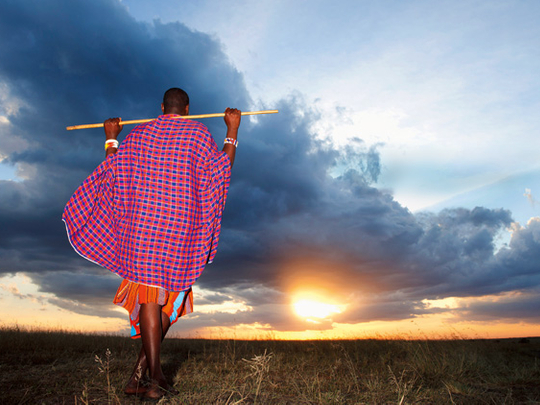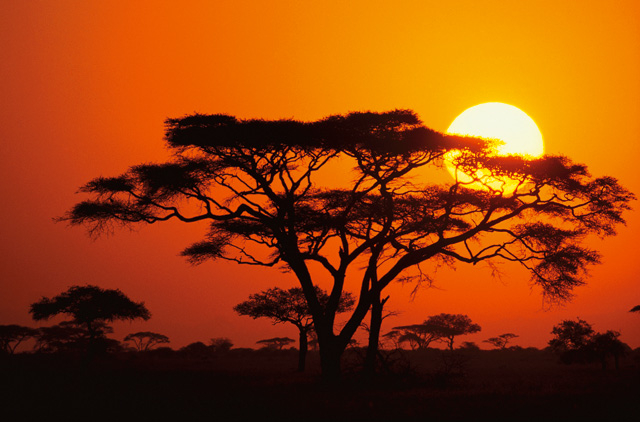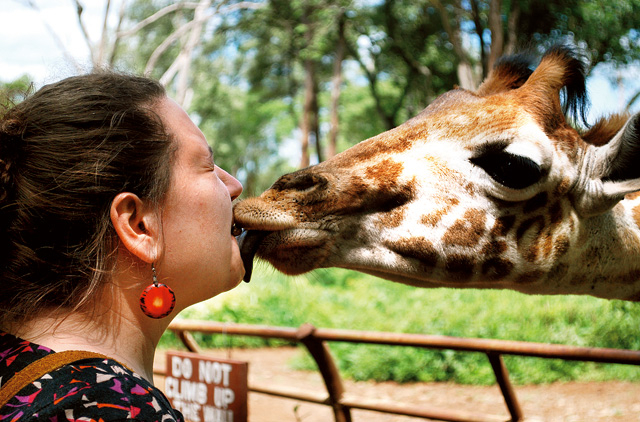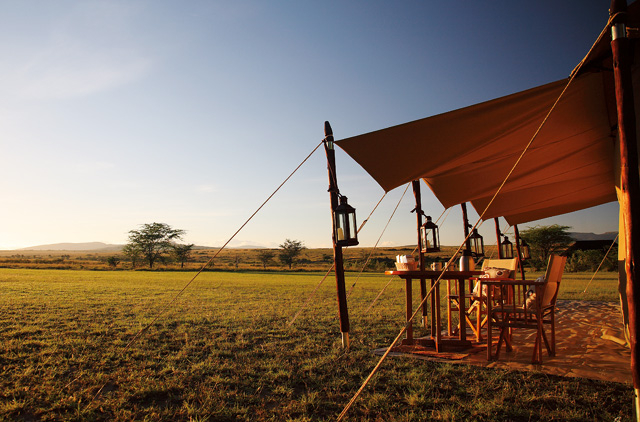
I peered out of the window of our 15-seat prop plane and watched Nairobi get smaller and smaller as we ascended and flew deep into the Kenyan countryside. An aerial view of congested roads intermingling with lush green spaces, slums, apartments, commercial towers and compounds soon gave way to a vast grassland inhabited by elephant, giraffe, lion, buffalo and, of course, the Masai people. I sat back in my seat and smiled; we were on our way to Masai Mara National Park.
After an hour-long journey, we touched down in an open airfield. Our safari driver, Peter, a Kenyan from a town near Nairobi, was waiting for us and we all piled into the open-roof 4x4. After a three-minute drive on a dirt trail, we arrived at the Serena Lodge.
I think a lot of people have misconceptions about safari holidays. You don't need to ‘rough it' and, in fact, most people opt to stay in camps and lodges that are just like any fully fledged hotel in any city in the world, complete with restaurant buffets, gift shops, pools and even spas. There's just one difference: there aren't many hotels outside Africa where you will see giraffe and elephant roaming through the grass, or buffalo cooling themselves in the wet squishy mud just outside your window.
Masai country
The land in the Masai Mara, referred to simply as ‘the Mara' by locals and seasoned safari enthusiasts, is a vast, mostly flat grassland with pockets of trees. There's an escarpment in the distance, and a river - the Mara River - that twists through the land.
We set out with Peter on our first ‘safari', which actually means ‘journey' in Swahili. On our first afternoon we spotted gazelle, antelope and topi by the dozen grazing in the field right outside our vehicle. We approached slowly so as not to scare them, and snapped pictures from the open roof and windows of our 4x4. Everyone satisfied, excited and keen to see more, we pressed on in search of bigger, more exotic animals.
After a few minutes we came to a herd of buffalo chomping on their favourite greens, looking at us curiously. We stared back. Buffalo are some of the most dangerous animals to humans as they can be highly unpredictable, Peter told us. This was a lesson we'd learn for ourselves later in the trip…
We came to a patch of trees and it was here that I saw giraffe and zebra for the first time in my life. I felt like a child; I was so excited and I couldn't stop grinning, staring and taking pictures. The giraffe were so tall - about five to six metres - yet they looked so gentle and kind - although Peter told us when they need to, they will fight with their strong, long necks. But that day, they were just enjoying their lunch in the sunshine, ambling gracefully across the land.
Next we headed to the banks of the Mara River. It is here, during the Great Migration, where some of the best hunts and animal-watching take place. From July until autumn people come to experience what I'm told is a truly magnificent sight. As the supply of grass dwindles in the Serengeti of Tanzania, thousands of wildebeest, zebra and other ‘plains game' cross into the Mara of Kenya, before they return in November.
The day we were there, we saw hippos bobbing up and down in the river's cool current, eyes popping in and out of the water, no doubt to check on their visitors. We went right to the river's edge and saw crocodiles sunning themselves on the rocks and baboons across the bank staring at their cousins.
As we continued our drive we spotted a slight sandy-coloured movement in the distance. We'd found our first pride of lions! There were about five female lions and three cubs all resting under the shade of a big tree. They weren't startled by our presence; they just minded their own business while we stared in awe.
We hit the trail again and stopped our vehicle next to some very tall grass. Peter told us to keep our eyes peeled. Sure enough, after a few minutes we spotted a cheetah! At first he was hiding in the tall grass but soon he came out for us to get a better look at him and we noticed that he was with his brother. We remained quiet and the duo didn't seem alarmed. They continued about their business walking through the grass. We were only about five metres away from them; close enough to count their spots. Then we realised that they were starting to get defensive as they began walking in a deliberate formation over and over to mark their territory. Peter said there was nothing to be afraid of but decided that we should leave them alone. "After all," he told us, "this is their home, not ours."
The sun was starting to set so we headed back to our lodge to eat a delicious meal at its buffet-style restaurant and exchange stories from the day with other guests around a campfire.
A close call
The next morning we woke up at 6am and met Peter for an early-morning game drive. We were in for a bit of excitement because en route we encountered a buffalo who decided he didn't like us much. We had stopped as usual to snap a few photos, but I guess he was camera shy. He picked up speed and charged right for our vehicle. Peter acted quickly, stepping on the accelerator and loudly hitting the outside of our car with his arm in an attempt to scare the buffalo off. It didn't work. The animal was still coming for us, but Peter did manage to get us out of the way just in the nick of time.
Once we were out of the way, I looked back. Just as quickly as he had charged, the buffalo had lost interest and was back to munching on grass. It was an exciting, adrenalin-filled moment. But now it was time for breakfast.
Peter took us back to the banks of the Mara River to eat on the bank right beside the hippos. Our experience with the buffalo made for great breakfast conversation. We boasted to other guests about our adventure and how our driver had spared us from danger.
The area beside the lazy hippos had been set up with tables and linens, hot food and fresh fruit. We knew we were safe because we had a Masai warrior with us for protection. After we ate he told us a little bit about his people's semi-nomadic culture. Masai rely on their herds of cattle for survival and so they travel in search of new grazing pastures.
The cattle's milk and blood are used for sustenance, while the hides are used for sleeping and to make sandals. They are a sign of wealth and often exchanged at a marriage. Our warrior and host wore the traditional red clothes of a Masai man - two Shúkà, or sheets, are wrapped around the body and tied over each shoulder and another is worn like a cape. The women wear some of the most beautiful beads I have ever seen.
We transferred to another camp, the Sarova Mara Game Camp, and spent one more day exploring the Mara before we had to say goodbye. The timing was perfect because just as our plane took off for our return to Nairobi, the skies opened up and it began to pour.
Kenyan capital
The land where Nairobi now stands was colonised by the British in 1899 and it became a stop along the railway between Uganda and Mombasa. Over time, the outpost grew into the city that later became the capital of British East Africa. Eventually, in 1963, it was named the capital of an independent Kenya. Today it's a lively and crowded metropolis, home to just over three million people.
You can arrange a city tour with Travel Wild staff, but still hot off our safari in the Mara, we were keen to see more animals - this time, a little more up close and personal. We first headed to David Sheldrick Wildlife Trust's Nairobi nursery for orphaned baby elephants. The programme reintegrates orphaned elephants back in to the wild. For one hour each day people are allowed to visit the babies while they play in the mud.
From there we headed to the African Fund for Endangered Wildlife's Giraffe Centre. Here we were given a handful of pellets, which we were allowed to feed them. It was so amazing to see my new favourite up close. They really are gentle giants. One of the people working there could see that I loved the giraffes so he told me I could get a kiss from the giraffe if I wanted. He told me to put the pellet between my lips and the giraffe would take it out. I did as I was told, closed my eyes and sure enough, the giraffe gave me a kiss and took his pellet. Definitely a once-in-a-lifetime experience and one of the highlights of the trip for me.
Crocodile on the menu
Before heading to the airport we ate lunch at Carnivore, a restaurant in Nairobi you simply cannot miss. You get a whole array of salads and sauces and then the servers come around with big hunks of meat on massive skewers and they carve off a slice right on to your plate.
There are all the regulars like chicken, beef and lamb as well as some lesser known meats like crocodile, buffalo and ostrich. I tried them all and they were all delicious. Well, that's not entirely true, the crocodile was a bit… tough. They'll keep bringing you cuts of meat until you lower the flag in the centre of your table and admit defeat. It's a great place for families and there's something to suit everyone, and there's even a vegetarian menu.
With a full camera and a full belly it was time to head home to Dubai. In four days I felt like I'd only just begun to see what this incredible country has to offer. Stories like Out of Africa and The Lion King have shown us a romantic and awe-inspiring view of this East African country, still nothing prepared me for the beauty of its land, the majesty of its animal inhabitants or the warmth of its people. I knew I was hooked. Kenya, I will return.
What I saw: Lions, buffalos, hippopotamus, warthogs, jackals, crocodiles, cheetahs, zebras, giraffes, topi, gazelles, antelope, elephants, tortoise, baboons, small monkeys, many colourful birds, rhinoceros





